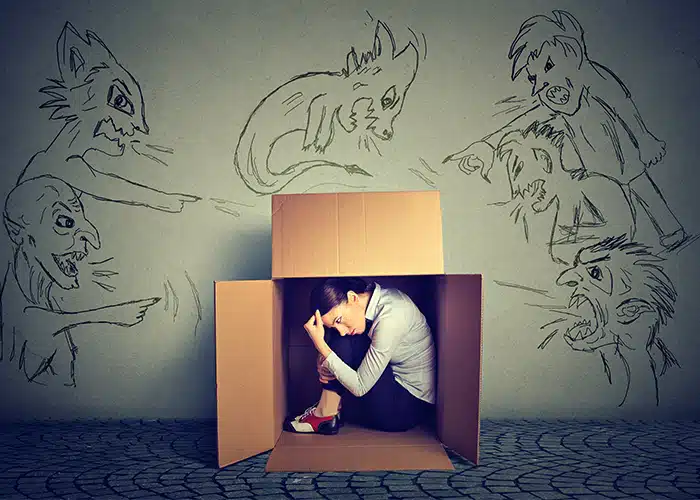A bit of anxiety every now and then is part of being human. For many of us, worrying and uneasiness are only temporary. But if you suffer from an anxiety disorder, you’re probably all too familiar with that nagging feeling that lasts for months, fears that get bigger as time goes on, and how all of this interferes with your everyday life.
As women, research shows, we’re almost twice as likely as men to get an anxiety disorder in our lifetime.1 The million-dollar question is why.
“In its most simple form, anxiety is the experience of tension between you and the present moment,” explains Katherine Schafler, LMHC, NYC-based women’s emotional health expert. And it can come in many forms, including generalized anxiety disorder (GAD), panic disorder, social anxiety disorder, obsessive compulsive disorder (OCD), and post-traumatic stress disorder (PTSD). Although anxiety doesn’t discriminate from one person to the next, it does seem to affect women more.
Fluctuations in sex hormones have been tagged as a possible cause for our boost in anxiety. But according to Margaret Altemus, MD, Director of the Payne Whitney Women’s Program at Weill Medical College Department of Psychiatry, we don’t know exactly why anxiety differs between women and men.2
“It doesn’t seem to be related to estrogen,” Dr. Altemus said in an Anxiety and Depression Association of America podcast. “In children, girls are twice as anxious as boys, so it’s even before the menstrual cycle starts that you see sex differences.”2 Being susceptible to anxiety, she explained, could go as far back as hormone levels in utero that may affect a developing fetus. Other possibilities that could contribute to the gender anxiety gap are major reproductive events and illnesses. Childbirth and the postpartum period have been seen to increase anxiety in women, as have reproductive diseases, such as uterine fibroids and endometriosis.3,4,5
And as if being from Mars and Venus weren’t enough, a woman’s brain chemistry differs greatly from that of a man’s, as do our coping mechanisms. When women face stress, they’re more likely to ruminate about their problems, writes Olivia Remes, anxiety researcher and doctoral candidate at the University of Cambridge in England.6 This can amplify anxiety. In contrast, she explains, men engage more in active, problem-focused coping.
Data has also shown that girls and women are more likely to encounter physical or mental abuse, and this experience is a known risk factor for PTSD. Childhood abuse may also change brain chemistry, affecting individuals as adults, predisposing them to anxiety disorders.7
Given all the potential associations and what-ifs, it’s clear more research needs to be done on behalf of our anxious minds. Science may not yet understand the connection between women and anxiety, but the good news is it’s treatable.
“When anxiety is ongoing, you may experience regular trouble sleeping, eating, and/or socializing. These are immediate signs that you need to get professional help,” Schafler tells Ask4UFE. It depends highly on the individual, she notes, but therapeutic interventions can include talk therapy, psychotropic medication, support groups, assertiveness training, animal-assisted therapy, and mindfulness exercises.
Women can also play an active role in their own treatment and engage in positive lifestyle changes like incorporating regular exercise, a healthy diet, and keeping positive relationships—this includes the relationship we have with ourselves.
“Surround yourself with people, places, and things that help you feel a sense of expansion, as opposed to contraction,” Schafler suggests. “Just as important as understanding who you are is understanding what you need.”
And never hesitate for one second to ask for it.
ABOUT THE THERAPIST Katherine Schafler, LMHC, is an NYC-based women’s emotional health expert. With dual master’s degrees in clinical assessment and psychological counseling from Columbia University and post-graduate training and certification from the Association for Spirituality and Psychotherapy in NYC, Katherine helps women change their lives for the better through counseling and tailoring her approach to meet the unique needs of each of her clients. You can find her at https://www.katherineschafler.com
REFERENCES
- Anxiety and Depression Association of America. (n.d.). Women and Anxiety. Retrieved from https://adaa.org/find-help-for/women/anxiety#
- Anxiety and Depression Association of America. (Producer). (n.d.). Anxiety Disorders in Women [Audio podcast]. Retrieved from https://adaa.org/learn-from-us/from-the-experts/podcasts/anxiety-disorders-women
- Shlomi, P. I., Huller, H. L., Baum, M., et al. (2014). Postpartum anxiety in a cohort of women from the general population: Risk factors and association with depression during last week of pregnancy, postpartum depression, and postpartum PTSD. Sr J Psychiatry Relat Sci, 51(2):128-134.
- Ghant, M. S., Sengoba, K. S., Recht, H., et al. (2015). Beyond the physical: A qualitative assessment of the burden of symptomatic uterine fibroids on women’s emotional and psychosocial health. J Psychosom Res, May;78(5):499-503.
- Friedl, F., Riedl, D., Fessler, S., et al. (2015). Impact of endometriosis on quality of life, anxiety, and depression: An Austrian perspective. Arch Gynecol Obstet, Dec;292(6):1393-1399.
- Remes, O. (2016, Jun 10). Women are far more anxious than men—here’s the science. Retrieved from https://theconversation.com/women-are-far-more-anxious-than-men-heres-the-science-60458
- Harvard Medical School. (2002). Coping with Anxiety and Phobias. Retrieved from http://hrccatalog.hrrh.on.ca/InmagicGenie/DocumentFolder/copinganxietyphobias.pdf







